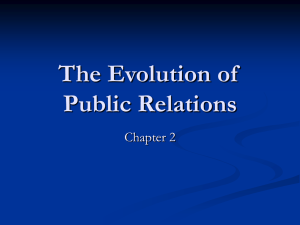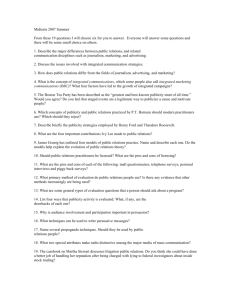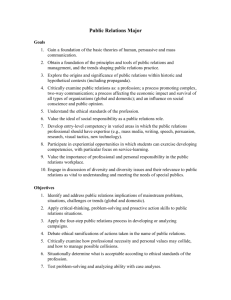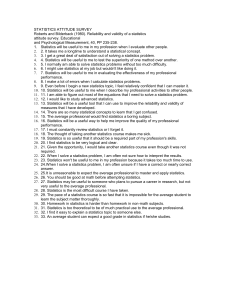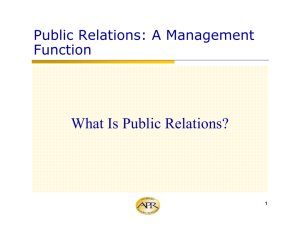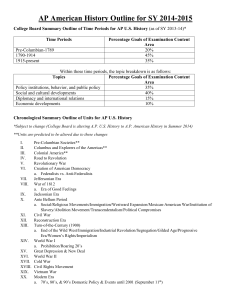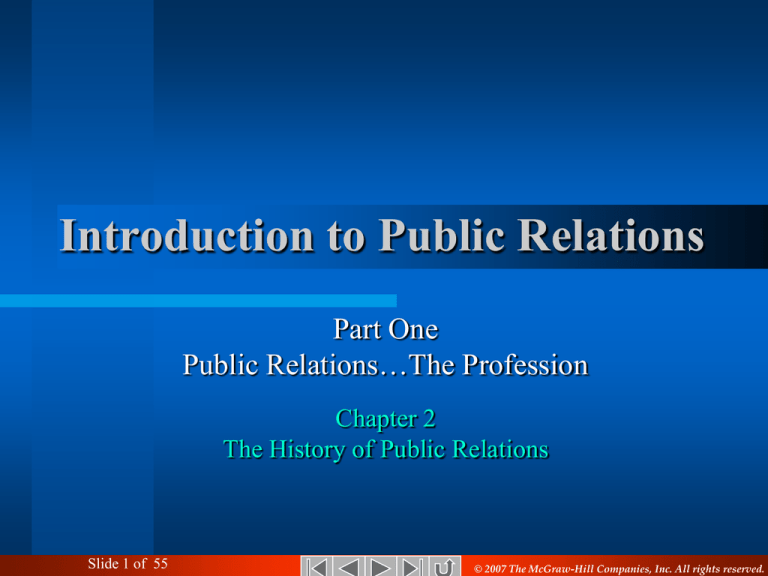
Introduction to Public Relations
Part One
Public Relations…The Profession
Chapter 2
The History of Public Relations
Slide 1 of 55
© 2007 The McGraw-Hill Companies, Inc. All rights reserved.
Introduction to Public Relations
History
Why Study the Historical Roots of
Public Relations?
To excel in a profession like public relations,
you must master its cultural roots.
•
•
What are the dynamics in a culture (past and
present) that make your discipline vital to
successful involvement in that culture?
What forces shaped your culture regarding how
people think and behave relative to your
profession?
Slide 2 of 55
Introduction to Public Relations
History
Made in America
•
•
•
Public relations as a profession was initially an
American phenomenon.
By the end of the 20th century, the same forces
were mandating a need for PR throughout the
industrialized world.
Leaders through the centuries have always
sought to influence their publics.
Let’s examine some early attempts.
Slide 3 of 55
Introduction to Public Relations
History
America—Dynamic Greenhouse
for Public Power
•
Unique and simultaneous political-cultural forces created
a new power for public opinion in young America:
•
•
•
•
•
•
A democratic and republican government of, by and for the
people
Free markets
Systems of checks and balances
A rise in affluence and education for “commoners”
An independent population voting with ballots and dollars
Such forces caused public relations to be made in
America.
Slide 4 of 55
Introduction to Public Relations
History
Public Relations in the Revolutionary
War
•
Before the American
Revolutionary War (17741783) began, colonial leaders
had no wish to pursue war
with Britain.
•
•
Slide 5 of 55
The revolution had to be a
popular war if democratic
ideas were to work.
Yet, the leaders recognized a
problem—only one-third of
Americans favored
independence.
Introduction to Public Relations
History
Public Relations in the Revolutionary
War
•
Two leaders of the revolution shrewdly appealed to
public sentiment.
•
Samuel Adams - a true campaigner
•
George Washington - a maximizer of success
Adams was before his time regarding influence…
Slide 6 of 55
Introduction to Public Relations
History
Samuel Adams—the Campaigner
A member of the Continental Congress,
Samuel Adams initiated a sustained, public
campaign to influence Americans to seek
independence by:
•
•
•
•
Using symbols that were easily identifiable
and aroused emotions.
Publicizing slogans that are still
remembered such as “Taxation without
representation is tyranny.”
Publicizing events such as “The Boston
Massacre” when the British fired into a
group of colonists.
Staging events such as the Boston Tea Party
to influence public opinion.
Slide 7 of 55
The Boston Tea Party—an act of AngloAmericans dressed as Native Americans.
Introduction to Public Relations
History
A Broad Appeal to the
People’s Idealism
After the Revolutionary War, the Federalist
Papers, a series of 85 newspaper essays about the
Constitution and the new form of government,
were published. The Federalist Papers appealed
to Americans for a form of government to guard
and enhance three values:
•
•
•
ideals of common justice
the general welfare of the public
the rights of individuals and private property
The widespread distribution of the Federalist
Papers led to the ratification of the U.S.
Constitution (1787-88).
Slide 8 of 55
Click image to view The
Federalist Papers
www.law.emory.edu
Introduction to Public Relations
History
“Public Sentiment Is Everything”
It was during the Civil War that
President Lincoln learned the value of
good public sentiment (or opinion).
Public sentiment is everything.
With public sentiment, nothing
can fail; without it, nothing can
succeed.
--Abraham Lincoln
Photo from the University of
Tennessee web site
www.SunSITE.edu
Slide
Slide9 9ofof5555
The Industrial Revolution Began a New
Era of Public Relations
The Industrial Revolution (19th-20th
centuries) was a landmark era for public
relations. At the end of the 19th century,
changes in social and economic conditions
mandated new relations between industry and
the public.
The Industrial Revolution brought about a
change in how products were made—from
using hand tools at home to using machine and
power tools in a factory.
There were new and not always pleasant
realities of American life:
•
•
•
The enforced rhythm of the factory
The stress of urban life
The vast distinction between bosses and
workers. During this era, public
relations began to develop as an
independent profession.
Three industrial forces…
Slide 10 of 55
Introduction to Public Relations
History
Three Major Industrial Forces
The modern public relations profession is an
outgrowth of three American forces in the 19th20th centuries:
•
•
•
Broad recognition of the power of public opinion
Competition among institutions for public support
Development of media to quickly influence public
opinion
Slide 11 of 55
Introduction to Public Relations
History
Corporate America’s Response
Business leaders recognized that new stresses on the
populace threatened production.
“Corporations gradually began to realize the importance
of combating hostility and courting public favor.”
—Marie Curtl
The term public relations came into use at this time.
The earliest appearance was probably in Dorman
Eaton's 1882 address to the graduating class of the Yale
Law School.
Slide 12 of 55
Introduction to Public Relations
History
American Industry Learned to
Value Public Image
Business leaders began to hire people adept at
understanding how to influence the public.
•
•
AT&T (1883): Theodore Vail hired Charles J.
Smith to manage company conflict with the public.
Westinghouse (1889): George Westinghouse,
patriarch of his famous electrical company, hired
E. H. Heinrichs to establish the first corporate
public relations department.
•
Slide 13 of 55
The goal was to win the fight against
Thomas Edison regarding how the nation
would be wired (AC or DC).
George Westinghouse used
PR to bring us AC current.
www.britannica.com
Introduction to Public Relations
History
A Classic Press Agent Approach
P. T. Barnum (d. 1891)—the master press agent:
•
The circus owner Barnum masterfully and,
some say, inaccurately used publicity to
make money.
Slide 14 of 55
Introduction to Public Relations
History
The First Publicity Bureau
In 1900, George Michaelis established the first
publicity bureau in Boston to serve businesses.
•
•
He gathered factual information about his clients
for distribution to newspapers.
By 1906, his major clients were the nation's
railroads that were seeking to head off adverse
regulations being promoted by President Theodore
Roosevelt.
Slide 15 of 55
Introduction to Public Relations
History
President Roosevelt
vs. the Railroads
•
President Roosevelt, who saw the
presidency as “a bully pulpit,'' proved
to be more than a match for the
Publicity Bureau.
•
The first president to make extensive use
of press conferences and interviews,
Roosevelt was said to rule the country
from the newspapers' front pages.
Slide
Slide 16
16 of
of 55
55
Introduction to Public Relations
History
The Father of Public
Relations—Ivy Lee
•
Lee made the first move toward the modern
practice of information sharing, such as
reporting on employee benefits and safety.
Some of his clients were:
•
•
Pennsylvania Railroad (1906-1909)
John D. Rockefeller and the Colorado Fuel
Strike (1914)
Slide 17 of 55
Introduction to Public Relations
History
Moving Toward Openness and
Honesty
•
•
Ivy Lee (d. 1934)
www.fredonia.edu/
Lee convinced the corporate clients of his
publicity agency (est. 1904) to become
more open and honest with the public.
His Declaration of Principles became the
forerunner to a PR Code of Ethics.
•
Slide 18 of 55
The public was no longer to be
ignored…nor fooled, in the continuing
manner of the press agent. —Eric Goldman
Introduction to Public Relations
History
The Persuasive Communication Tradition
•
•
•
The Creel Committee in World War I can be credited
with developing persuasive techniques to influence the
American public to support the war and buy bonds.
Edward Bernays and Carl Byoir were two of those PR
practitioners coming out of this WWI tradition to launch
public relations into the next decades.
Elmer Davis and the Office of War Information in
World War II continued this social science approach to
influencing opinion with considerable experimental
opinion research done to provide the theory for the PR
programs.
Slide 19 of 55
Introduction to Public Relations
History
Edward Bernays—Pioneer
of PR Education
Edward Bernays made significant
contributions to equipping practitioners
for effective service. He taught the first
collegiate public relations course at New
York University (1923) and wrote the first
public relations textbook, Crystallizing
Public Opinion .
Bernays developed three tools to influence
public consent:
•
•
•
market research
social surveys
public opinion polls
Slide 20 of 55
Click image to read a biography of Bernays
(center). Photo from the Museum of Public
Relations (prmuseum.com).
Introduction to Public Relations
History
Committee on Public Information
President Woodrow Wilson turned
public relations from a defensive tool
to an offensive one when he set up
the Committee on Public
Information in 1917 to gain support
for World War I.
Led by newspaper man George
Creel, the Committee on Public
Information was a phenomenal
success.
On May 1, 1917, there were 350,000
holders of U.S. Bonds. Six months
later, 10 million held bonds.
Slide 21 of 55
The Censor Board of the Committee on Public
Information; George Creel is seated on the far
right. Photo from http://www.thehistorynet.com.
Introduction to Public Relations
History
Relationship-building and Two-way
Communication Tradition
Now public relations opens a two-way door for
influence.
It became increasingly obvious to practitioners that
organizations communicate with the public not only by words
but also by their response to public opinion.
This new awareness allowed practitioners to advise
management as well as inform the public.
Consequently, public relations professionals gained a place in
the heart of business organizations—the decision-making and
operational aspects.
Ivy Lee was again in the vanguard…
Slide 22 of 55
John D. Rockefeller and the
Colorado Fuel Strike
•
•
Out of the 22 deaths
in the Ludlow
Massacre, 13 were
women and
children.
Click this box to view
photographs of the massacre
circulated at the time.
Slide 23 of 55
The Ludlow Massacre at the miners strike
(1914) against Colorado Fuel and Iron
Company shocked the nation.
•
•
In desperation, John D. Rockefeller, Jr., the
key stockholder, gave Ivy Lee the
opportunity to become a consultant on the
internal workings of his coal business.
Lee strongly recommended to Rockefeller
that he improve communications with miners
and establish mechanisms to redress workers'
grievances.
Lee’s emphasis on counseling management to
take positive action marked a major shift in
public relations theory and practice.
Introduction to Public Relations
History
Inward Focus on Employees Expands
•
In addition to its outward focus, public relations
expanded its inward focus. This had several results.
•
•
•
Employees became recognized as a significant public.
Ivy Lee persuaded his client American Tobacco Company to
introduce profit-sharing for its employees.
By 1925, more than half of all major manufacturing
companies were publishing employee magazines.
The practice moves upward…
Slide 24 of 55
Introduction to Public Relations
History
AT&T and Arthur Page
Arthur Page accepted AT&T’s offer of PR vice
president on the condition that he would have a
voice in company policy. Page set out to win
public confidence. This required a continuous
and planned program of positive
public relations.
•
•
Click on the image to read a short
biography of Arthur Page, a giant of
a PR practitioner. Photo from
prmuseum.com.
Slide 25 of 55
•
AT&T went directly to the public
with a film program for schools and
civic groups.
AT&T paid fees for employees to
join outside organizations as
representatives.
Finally, the company sought to have
as many people as possible own its
stock.
Introduction to Public Relations
History
Events That Shaped PR in mid 20th Century
•
Two mid-20th century events significantly
shaped the American culture.
•
•
•
The Great Depression
World War II
Those events also influenced the development of
public relations as an agent of mutual influence.
How did the Depression affect public relations?
Slide 26 of 55
Introduction to Public Relations
History
The Depression Brought Compassion
•
Workers looking for work in the
Great Depression. Click the
image to see what life was like
in the 1930s.
Photo © 2001 Britannica.com Inc
Slide 27 of 55
Public relations people began to
emphasize a new approach to their
publics—one of seeking mutual
influence through understanding
(Stage 3).
•
•
They sought to understand the
desperate needs of their publics.
They facilitated acts of
compassion on the part of their
clients.
Introduction to Public Relations
History
The Prestige of the Populace
Increased
•
The flow of capital and production evaporated after the market
crash of 1929.
•
•
The need for an informed public became more vital as government,
business and labor competed for public support for the use of limited
resources.
Persuasion and publicity could be effective only when they
were coupled with responsible performance.
•
The practitioner was called upon to help organizations pursue
responsible performance to increase public respect.
War gave PR a permanent place in government…
Slide 28 of 55
Introduction to Public Relations
History
Military Adopted Public Relations
in World War II (1939-1945)
•
The deteriorating military and political situation in
Europe caused the military to increase its practice of
public relations in the 1930s.
•
•
Each branch of the service built its own public relations
apparatus to promote its particular form of warfare.
The Army's PR efforts employed 3,000 military and civilian
personnel.
How Hitler captured public relations…
Slide 29 of 55
Introduction to Public Relations
History
Hitler’s Nazi Party Became
Masters of Public Relations
The greatest application of public
relations techniques in the 1930s occurred
in Germany.
Click here to read
The Nazi propaganda machine under
Joseph Goebbels viciously used press
agentry.
The Nazis demonstrated both the dangers and
the effectiveness of propaganda.
Slide
Slide
3030
of of
55 55
about the Americanborn Axis Sally. She
made propaganda
broadcasts for Radio
Berlin in
Hitler's Germany.
Introduction to Public Relations
History
US Office of War Information
Mobilized a Nation
•
•
In June 1942, with America fully engaged in the
war, the Office of War Information (OWI) was
established under Elmer Davis.
A massive public relations effort was mounted
to rally the home front.
Slide 31 of 55
Introduction to Public Relations
History
OWI Developed a Broad PR Campaign
•
The goal of the Office of War Information was
to implement massive mobilization strategies:
•
•
•
•
•
selling war bonds
rationing food, clothing and gasoline
planting victory gardens
recruiting military personnel
promoting factory productivity and efficiency
Read these posters through
the eyes of a soldier’s wife…
Slide 32 of 55
Introduction to Public Relations
History
Images that Mobilized a Nation at War
These posters were printed for the Office of War Information and retrieved from the National
Archives and Records Administration web site at http://www.archives.gov.
Slide
Slide
3333
of of
55 55
Introduction to Public Relations
History
Influx of PR Practitioners after WWII
Click on the picture to hear about PR after WWII.
Slide 34 of 55
Introduction to Public Relations
History
The Legacy of the OWI
Remains Today
•
Several important communication agencies that are still active
today trace their beginnings to OWI:
•
•
United States Information Agency (USIA)
The Voice of America radio network
•
•
The first broadcast (1942) of the VOA was in German, intended
to counter Nazi propaganda. By 1945 the VOA was
broadcasting in 40 languages weekly.
The Advertising Council
In war the foundation was laid for sophistication of
public relations in business.
Slide 35 of 55
Introduction to Public Relations
History
Post World War II Era Saw
Increased Sophistication
•
The post war era witnessed tremendous growth of public relations as a
sophisticated profession.
•
•
•
•
Practitioners such as Earl Newsom with Standard Oil (1945) were
increasingly invited to participate in policy decision making.
During this period, new emphasis was placed on public relations
functions ( and on more sophisticated PR tools (e.g., audience
analysis).
Carl Byoir used public relations techniques to raise money nationally
to help polio victims and to find a cure for the crippling disease.
Harold Burson began his PR agency in 1946; merged with Bill
Marstellar in 1953. Burson-Marstellar became the largest public
relations agency in the world. It remains one of the top agencies
today.
A place in the university…
Slide 36 of 55
Introduction to Public Relations
History
Development in Education and Ethics for
Public Relations
•
Boston University established the first school of
public relations (1947).
•
•
Two years later, one hundred colleges and
universities offered classes in the subject.
In 1954, the Public Relations Society of
America (PRSA) developed the first code of
ethics for the profession.
•
Slide 37 of 55
The society set up a grievance board for code
enforcement in 1962 and a program of voluntary
accreditation in 1964.
Introduction to Public Relations
History
Moss Kendrix Changed Perceptions
about African-Americans
•
•
•
Moss Kendrix (1917-1989) was a public
relations pioneer in transforming racial
stereotyping.
Kendrix used advertising to influence how
Americans viewed black citizens.
American icons such as Carnation, the
Ford Motor Company, and the Coca-Cola,
employed Kendrix to create campaigns
that targeted the black community.
Click on the image to read about
Kendrix’s amazing legacy. Photo
from www.prmuseum.com.
Slide 38 of 55
Introduction to Public Relations
History
Increased Role of Government in
Organizational Life
Business/government relations became increasingly
important as the federal government entered a new era
of regulation.
Such regulations came in part because
of several issues in the 1970s-80s:
•
•
•
•
•
civil rights and equal opportunity
environmentalism
consumerism
urban problems
nuclear power
Slide 39 of 55
March 1965 civil rights march travels 54
miles in Alabama regarding voting rights.
Photo taken from www.msnbc.com.
Introduction to Public Relations
History
Review of Principles from the
Second Millennium
From the second millennium lesson, we realized that…
1. Historical leaders influenced their worlds through timely mixtures of
passion and words.
2. Even powerful people cannot ignore the opinion of the public.
3. Democracy is dependent on a strong, opinionated public.
4. An intentional and sustained campaign to broadly influence the public
can be very effective.
5. Publishing one’s successes affects indifferent public opinion.
6. A wide distribution of rational appeal to the public’s values influences
their thinking and behavior.
Slide 40 of 55
Introduction to Public Relations
History
Review of Principles from the
Industrial Revolution
The public relations profession was born in the industrial
age through dynamic changes in American life.
•
•
•
Organizations must accept the need to deal with public
opinion.
In a media-strong democracy, the public can powerfully
express its opinion.
PR professionals help organizations avoid costly expressions
of public discontent in an age of fierce competition for public
support.
Slide 41 of 55
Introduction to Public Relations
History
Review of Principles Since 1930
•
•
•
The Depression-War era led public relations to value
mutual influence and develop massive, sophisticated
strategies to communicate with and influence the public.
Public relations became a respected, sophisticated and
expanded profession during the post-WWII era, largely
through governmental and public influence.
Currently public relations is evolving as a force for
adaptation to public concerns on vital issues.
Slide 42 of 55
Introduction to Public Relations
History
In Summary…
Since its inception, Public Relations has
undergone several changes. These changes were
usually brought about by changes in the
environment in which people lived. Practitioners
must be aware of the history of PR and anticipate
changes in the present and future of Public
Relations.
Slide 43 of 55
Introduction to Public Relations
History
Slides not used in class
Slide 44 of 55
Introduction to Public Relations
History
Today’s Learning Objectives are…
•
•
•
•
•
Understand that people cannot ignore public opinion
Realize how a democracy is dependent on public opinion
Discover how two major forces influenced the development
of public relations in the United States during the 1930s.
Trace how PR became a respected and sophisticated
profession during the post-WWII era.
Comprehend how public relations is currently changing at the
start of the 21st century.
Is public relations history important?
Slide 45 of 55
Introduction to Public Relations
History
Great Communicators of
the Pre-modern Era
•
Who would you say influenced the public the most by
delivering a speech?
•
•
•
•
•
•
Pope Urban II
Abraham Lincoln
Winston Churchill
Martin Luther King
Johnny Carson
Many historians believe that Pope Urban did. Never
heard of him, you say?
How a speech united a continent…
Slide 46 of 55
The Speech that Inflamed a Continent
•
Pope Urban declared the misdeeds of the Seljuks in a
speech given in Claremont, France (A.D. 1095).
•
•
In his speech, he challenged Europe to
send an army to protect the holy places
and Christian visitors in Palestine from
the Seljuk Turks.
Europe overwhelmingly responded to
Urban’s challenge, and thus began the
Crusades that lasted for two centuries
From Pope Urban we learn:
•
•
Click image to read Pope Urban’s speech.
Slide 47 of 55
To influence people, we must identify
sincerely with their common passions.
We must clearly and publicly express
our aspirations.
The Timing of Luther’s List
•
Martin Luther began the Protestant
Reformation with a list of grievances.
In 1517 he publicly posted a list of 95
grievances he held against the church
leaders in Rome. Within a few years, half
of Europe supported Luther’s ideas.
•
•
A few decades earlier, Luther probably
would have been burned at the stake for
his protest (as was Jon Hus).
But in 1517, much of Europe was
brewing for radical change and Luther
knew it.
Slide 48 of
Click to read a few of Luther's
arguments in his 95 Theses.
Introduction to Public Relations
History
The Role of Public Opinion
•
Throughout history, leaders have courted public
sentiment to sustain their power.
Even monarchies or dictators cannot afford to ignore
public attitudes. They often take pains to assure that
their subjects are supportive of their regime.
•
•
Constitutional monarchies and democracies arose
from a self-consciousness of the people.
One change was indirectly influenced by an
unpopular, political philosopher.
That philosopher was Locke…
Slide 49 of 55
Introduction to Public Relations
History
The Influence of John Locke
The concept of the natural right of people to
oversee their rulers was developed by English
philosopher John Locke (d. 1704) and later
adopted by Thomas Jefferson. Locke taught
radical ideas that were very unpopular with
European rulers but became accepted in
America, such as…
•
•
Governments derive their power from the
consent of their subjects.
John Locke
Democracy is a very advanced and more natural
form of government.
Democracies thrive on public opinion…
Slide 50 of 55
Introduction to Public Relations
History
Three Stages of PR Development
•
•
Development of these traditions were sequential, but all
three still exist to some extent today.
•
•
•
Rhetorician
Press Agent
Journalistic/Publicity Tradition
Today, though, public relations is moving…
•
•
away from using any available means to achieve desired public
opinion
toward informing the public and providing information and
counsel to management
Slide 51 of 55
Introduction to Public Relations
History
I. Rhetoricians
The early aspects of public relations in trying to
influence publics through what was said, not
necessarily what was done.
Illustrated men such as by:
Caesar
Pope Urban
Samuel Adams
Slide 52 of 55
“Propaganda of the Deed”
•
•
In the quest to gain media and public
attention, press agentry became
increasingly outrageous, exploitive,
manipulative, and even cruel.
Paul Brousse (French sociologist in
1878) argued for:
•
•
•
The Propaganda of the Deed : the idea
justified the need for actions to gain
public attention to political
ideas/grievances.
For European anarchists in the late
nineteenth century, propaganda of the
deed meant bombing, murder, and
assassination.
Propaganda of the deed became known
as terrorism after the 1960s.
Slide 53 of 55
Smoke billowing over Tulsa,Oklahoma
during 1921 race riots, Alvin C. Krupnick
Co., photographer, Library of Congress
The Rise of Non-violent
Press Agentry
The twentieth century witnessed the use of
non-violent, staged events to draw attention to
social/political issues.
Mahatma Gandhi ingeniously used nonviolence to bring independence to India
(1930-1947).
Inspired by Gandhi, Martin Luther King, Jr.
successfully applied non-violent events to
change American attitudes and laws about civil
rights for black Americans (1960s).
The way Gandhi even dressed
and traveled were meant to
influence public opinion. To
learn more about Gandhi, visit
this site: www.nuvs.com/ashram
Slide 54 of 55
Introduction to Public Relations
History
Press Agentry and Hostility
•
•
•
The success of press agents in attracting
attention and a public response often results in
hostility from the press and the public.
Such results are assured if the publicity is coupled
with blatantly deceptive and manipulative tactics.
Press agentry gave public relations a bad name
that persists to this day.
Public relations practitioners should use press
agentry only with high ethics and great care.
From manipulation to cooperation…
Slide 55 of 55
Introduction to Public Relations
History
III. Journalistic/Publicity Tradition
•
•
By the early 1900s, businesses were forced to submit to
three new dynamics:
•
•
•
numerous governmental regulations
increasingly hostile criticism from the press
rise of the American labor union movements
Public relations moved from the stage of press agentry
to an era of public cooperation through distribution of
accurate information.
Slide 56 of 55
Introduction to Public Relations
History
The End of Corporate America’s Era of
Success
•
The Great Depression (1929-1939) witnessed thousands
of bankruptcies and the vanishing of great wealth.
•
•
Business was viewed as a failed
institution, unable to sustain
prosperity.
Corporate public relations
became less negative and
more of a positive and
continuous program to rebuild
confidence.
Slide 57 of 55
After the Wall Street crash of 1929, the Dow
Jones did not recover its lost stock points until
the mid-1950s.

